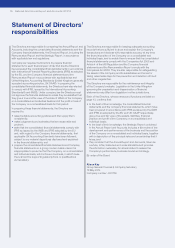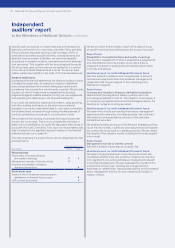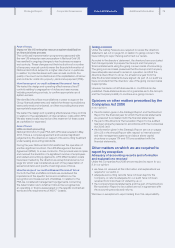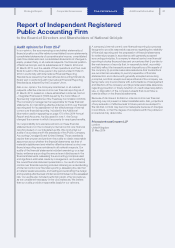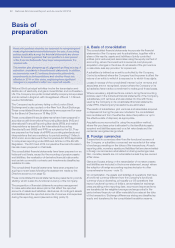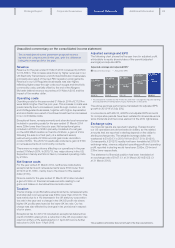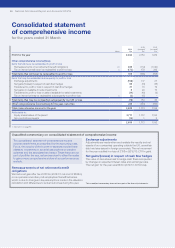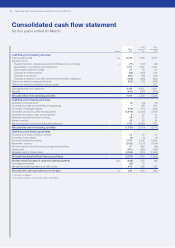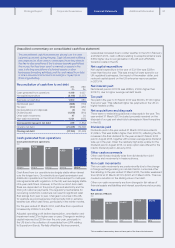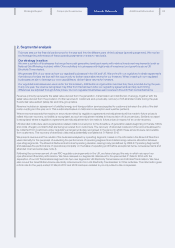National Grid 2014 Annual Report Download - page 85
Download and view the complete annual report
Please find page 85 of the 2014 National Grid annual report below. You can navigate through the pages in the report by either clicking on the pages listed below, or by using the keyword search tool below to find specific information within the annual report.
Strategic Report Corporate Governance Financial Statements Additional Information
Recent accounting
developments
New IFRS accounting standards and
interpretations adopted in 2013/14
During the year ended 31 March 2014, with the exception of IAS 19
(revised), and in respect of disclosures required by IFRS13 ‘Fair
value measurements’, the Company has not adopted any new
IFRS, IASor amendments issued by the IASB, or interpretations
issued by the IFRS Interpretations Committee (IFRIC), which have
had a material impact on the Company’s consolidated financial
statements. The impact of IAS 19 (revised) is set out in note 1. The
additional disclosures required by IFRS 13 are included in note 30.
Other standards, interpretations and amendments issued by the
IASB and IFRIC that have not had a material impact on the
Company’s consolidated results or assets and liabilities are:
• IFRS 10 ‘Consolidated financial statements’;
• IFRS 11 ‘Joint arrangements’;
• IFRS 12 ‘Disclosure of interests in other entities’;
• amendments to IAS 27 ‘Separate financial statements’ and
IAS28 ‘Investments in associates and joint ventures’ as a
resultof the adoption of the above standards;
• amendments to IAS 1 ‘Presentation of financial statements’;
and
• amendments to IFRS 7 ‘Financial instruments: Disclosures’.
New IFRS accounting standards and
interpretations not yet adopted
The Company enters into a significant number of transactions that
fall within the scope of IFRS 9 ‘Financial instruments’. The IASB
iscompleting IFRS 9 in phases and the Company is evaluating the
impact of the standard as it develops. It is currently expected that
the standard will be required to be adopted by the Company on
1April 2018. We are currently assessing the likely impact of this
standard on the Company’s consolidated financial statements.
Other standards and interpretations or amendments thereto
whichhave been issued, but are not yet effective, are not
expected to have a material impact on the Company’s
consolidated financial statements.
C. Areas of judgement and key sources of
estimation uncertainty
The preparation of financial statements requires management to
make estimates and assumptions that affect the reported amounts
of assets and liabilities, disclosures of contingent assets and
liabilities and the reported amounts of revenue and expenses
during the reporting period. Actual results could differ from these
estimates. Information about such judgements and estimations is
contained in the notes to the financial statements, and the key
areas are summarised below.
Areas of judgement that have the most significant effect on the
amounts recognised in the financial statements are as follows:
• the categorisation of certain items as exceptional items,
remeasurements and stranded cost recoveries and the
definition of adjusted earnings – notes 4 and 7; and
• energy purchase contracts classification as being for normal
purchase, sale or usage – note 27.
IFRS provides certain options available within accounting standards.
Choices we have made, and continue to make, include the following:
• Presentational formats: we use the nature of expense method
for our income statement and aggregate our statement of
financial position to net assets and total equity. In the income
statement, we present subtotals of total operating profit, profit
before tax and profit from continuing operations, together
withadditional subtotals excluding exceptional items,
remeasurements and stranded cost recoveries. Exceptional
items, remeasurements and stranded cost recoveries are
presented separately on the face of the income statement.
• Customer contributions: contributions received prior to
1July2009 towards capital expenditure are recorded as
deferred income and amortised in line with the depreciation
onthe associated asset.
• Financial instruments: we normally opt to apply hedge
accounting in most circumstances where this is permitted.
Fornet investment hedges, we have chosen to use the spot
rate method, rather than the alternative forward rate method.
Key sources of estimation uncertainty that have significant risk of
causing a material adjustment to the carrying amounts of assets
and liabilities within the next financial year are as follows:
• impairment of goodwill – note 9;
• review of residual lives, carrying values and impairment charges
for other intangible assets and property, plant and equipment
– notes 10 and 11;
• estimation of liabilities for pensions and other post-retirement
benefits – notes 22 and 29;
• valuation of financial instruments and derivatives – notes 15
and30;
• revenue recognition and assessment of unbilled revenue –
note2;
• recoverability of deferred tax assets – note 6; and
• environmental and decommissioning provisions – note 23.
In order to illustrate the impact that changes in assumptions could
have on our results and financial position, we have included
sensitivity analysis in note 33.
83





